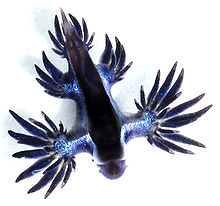| Glaucilla marginata | |
|---|---|

| |
| Glaucilla marginata | |
| Scientific classification | |
| Kingdom: | |
| Phylum: | |
| Class: | |
| (unranked): | clade Heterobranchia
clade Euthyneura clade Nudipleura clade Nudibranchia clade Dexiarchia clade Cladobranchia clade Aeolidida |
| Superfamily: | |
| Family: | |
| Genus: | Glaucilla
|
| Species: | G. marginata
|
| Binomial name | |
| Glaucilla marginata Bergh, 1860
| |
| Synonyms | |
| |
Glaucilla marginata is a species of small, floating, blue sea slug; a pelagic aolid nudibranch; a marine opisthobranch gastropod mollusk in the family Glaucidae. It is the only species in the genus Glaucilla, but is sometimes included in Glaucus with the closely related Glaucus atlanticus instead.[1][2] It’s common name is the sea lizard [3]. Although Glaucilla marginata is more commonly used, Glaucus marginatus can be used interchangeably.
Founder
editThe Glaucilla marginata was first reported by a Rudolph Bergh in 1860. He worked as a physican and a zoologist with a specialty in molluscs, specifically the nudibranch. In his time, he became the leading expert on the nudibranch and made great contributions to the nervous and reproductive systems of the nudibranch.
Distribution and Habitat
editThe Glaucilla marginata is pelagic, and can primarily be found near Southern Africa, Southern Australia and New Zealand.[4] These small nudibranchs float upside down on the surface tension in temperate and tropical seas.
Description
editThis nudibranch is dark blue, and in many ways it resembles a smaller version of Glaucus atlanticus. Its color varies in degree but is primarily bluish-brown with a light blue to silver underbelly. Unlike the Glaucus atlanticus, the Glaucilla marginata sports four groups of papillae arranged in multiple rows. These papillae cluster numbers have been seen to exceed 125 in number. [5] However, in this species the cerata (saw teeth on the skin) are arranged in a single row in each arch, while in Glaucilla there are multiple rows.
Diet
editThey eat colonial cnidarians such as the Portuguese Man of War.[2]
Natural Defenses
editThe Glaucilla marginata has multiple methods of self-defense. It’s unique coloring provides for easy camouflage. Because the Glaucilla marginata floats upside down along the surface of the ocean, their foot and undersides of the cerata are silver-blue and serve as a type of camouflage for flying predators. Meanwhile, along it’s "true" dorsal surface the coloring is darker which serves to protect this nudibranch from fish predators below.[6]
However, camouflage is not the Glaucilla marginata’s only defense. Because of this nudibranch’s, diet they use the venom stored from the largest nematocysts of the Portuguese Man of War stored in specialized sacs called cnidosacs.
References
edit- ^ "Glaucus". WoRMS. World Register of Marine Species. Retrieved 5 August 2012.
- ^ a b Valdés A. & Campillo O.A. (2004) Systematics of pelagic aeolid nudibranchs of the family Glaucidae (Mollusca, Gastropoda). Bulletin of Marine Science 75(3): 381–389.[1]
- ^ Umbers, Kate (22). "On the perception, production and function of blue colouration in animals". Journal of Zoology. 289 (4): 229–242. doi:10.1111 (inactive 2023-08-02).
{{cite journal}}: Check|doi=value (help); Check date values in:|date=and|year=/|date=mismatch (help); Unknown parameter|month=ignored (help)CS1 maint: DOI inactive as of August 2023 (link) - ^ Shields, Christopher (August 2009). "Nudibranchs of the Ross Sea, Antarctica: phylogeny, diversity, and divergence" (PDF).
{{cite journal}}: Cite journal requires|journal=(help)CS1 maint: date and year (link) - ^ Rudman, W.B. "Sea Slug Forum, Glaucilla marginata". Sea Slug Forum. Retrieved 05/31/2013.
{{cite web}}: Check date values in:|accessdate=(help) - ^ Rudman, W.B. "Sea Slug Forum, Glaucus atlanticus". Sea Slug Forum. Retrieved 05/31/2013.
{{cite web}}: Check date values in:|accessdate=(help)
- Bergh, L.S.R. (1860). Om Forekomsten af Neldefiim hos Mollusker. Vidensk. Meddel. Naturh. Foren. Kjöbenhavn, p. 309-331, pl. 8.
- Burn R. (2006) A checklist and bibliography of the Opisthobranchia (Mollusca: Gastropoda) of Victoria and the Bass Strait area, south-eastern Australia. Museum Victoria Science Reports 10:1–42.
- Australian Museum Online sections - sea slug forums
External links
edit